Abstract
STUDY OBJECTIVE: Screening recommendations for colorectal cancer include sigmoidoscopy in asymptomatic, average risk persons aged 50 and over and colonoscopy every three to five years in high risk groups. Little is known about the eligible population's compliance with endoscopic screening. This is the first Italian report of an endoscopic screening programme for colorectal cancer patients' relatives. DESIGN: In 1986, a pilot project for colorectal cancer screening by endoscopy in high risk subjects was started in the Desio (Milan, Italy) public health service region. The results obtained after seven years are described. SETTING: The names of 536 inhabitants with colorectal cancer diagnosed between January 1975 and December 1984 and their relatives' addresses were obtained from the Regione Lombardia Health System records and from the municipal registry offices respectively. PARTICIPANTS: From October 1986 to October 1993, 778 first degree relatives aged 20-75 were offered colonoscopy. MAIN RESULTS: After seven years, 233 (29.9%) had undergone endoscopic examination, mostly up to the splenic flexure. Being > 60 in age at the start of the programme negatively affected the participation (p < 0.05). Two cancers were detected and adenomatous polyps were found in another 24 of those screened (frequencies 0.9% and 10.3% respectively). Male gender (p < 0.05), increasing age in males (p < 0.01), and two or more affected relatives in females (p < 0.01) positively affected the frequency of polyps detection. CONCLUSION: These results suggest that about 30% of the eligible population would comply at least with sigmoidoscopic screening. The collaboration of family doctors and more widespread public information about the ability to cure colorectal cancer are necessary for better compliance.
Full text
PDF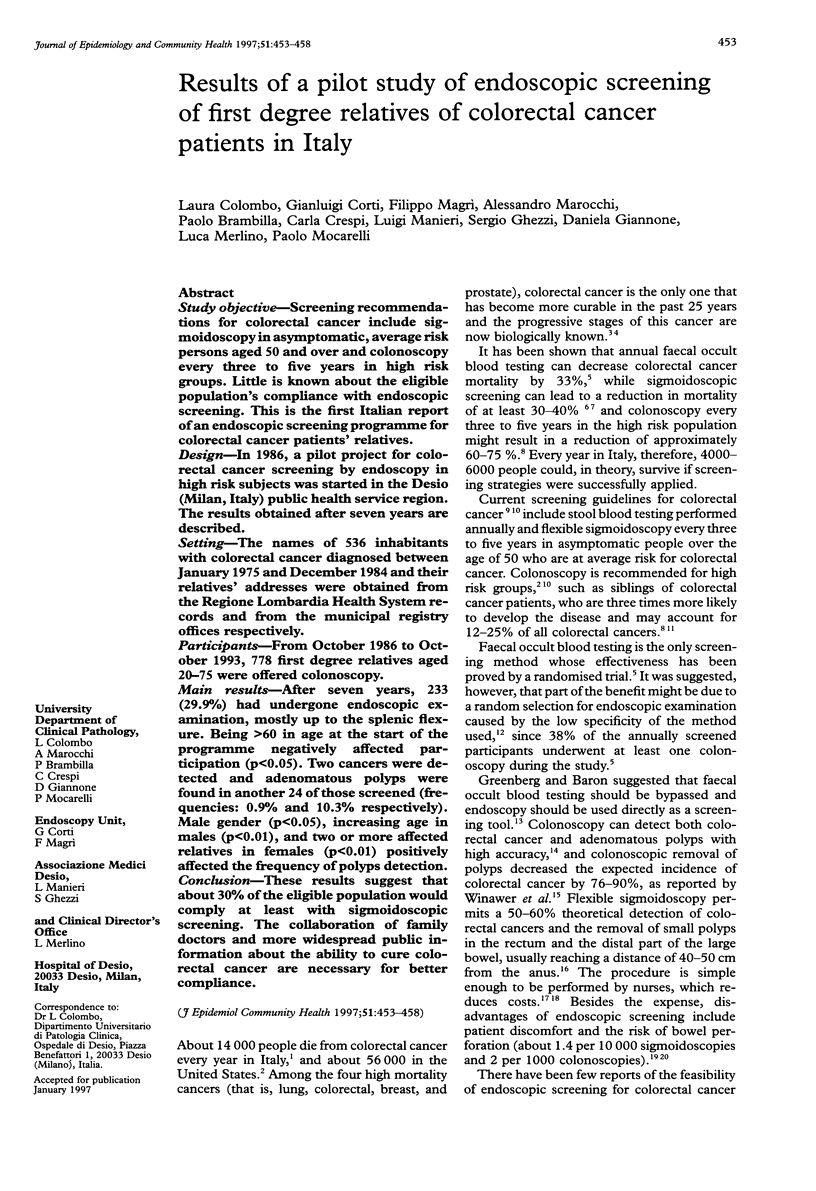
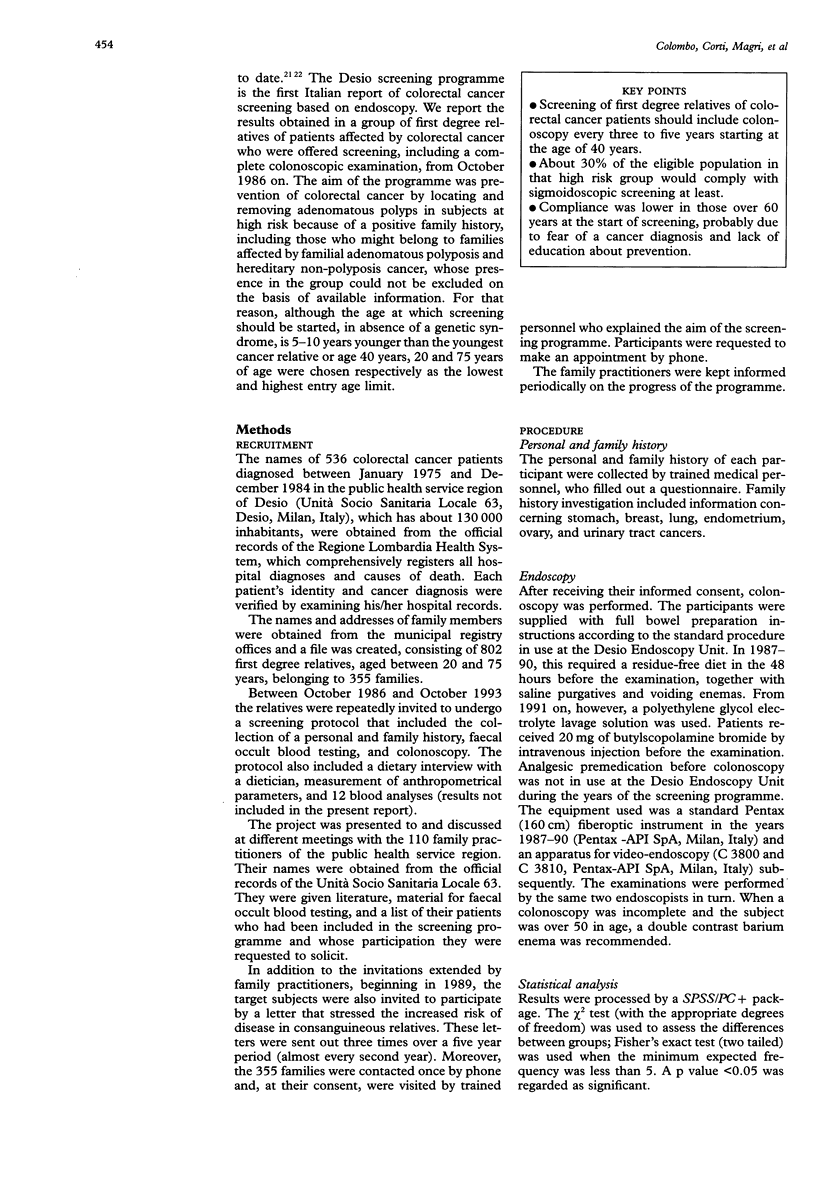
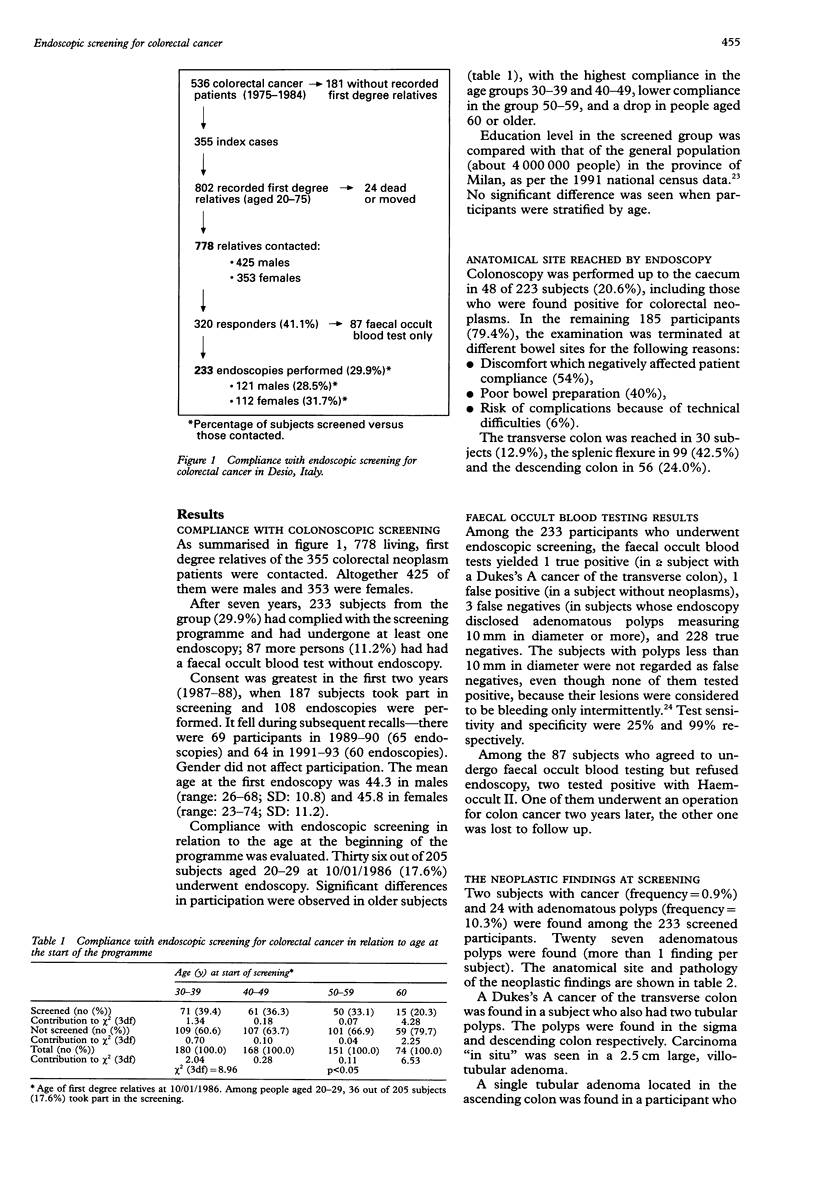
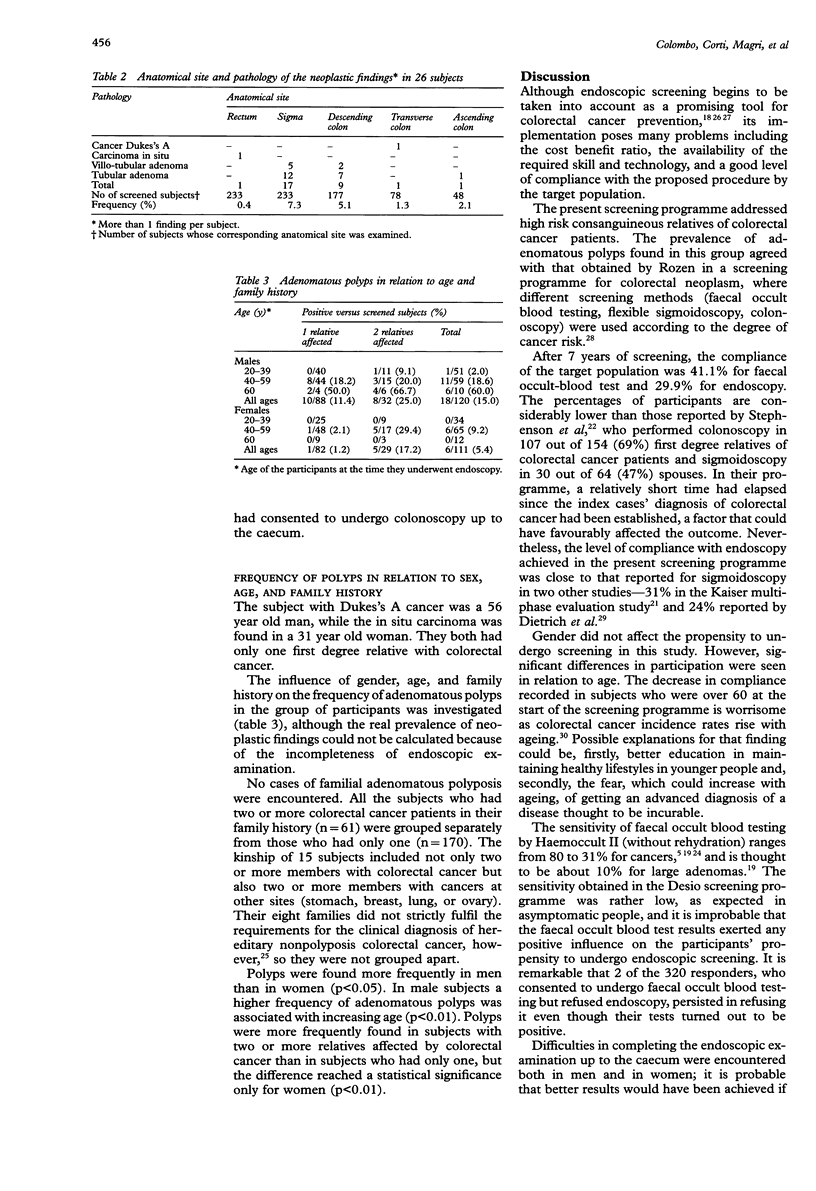

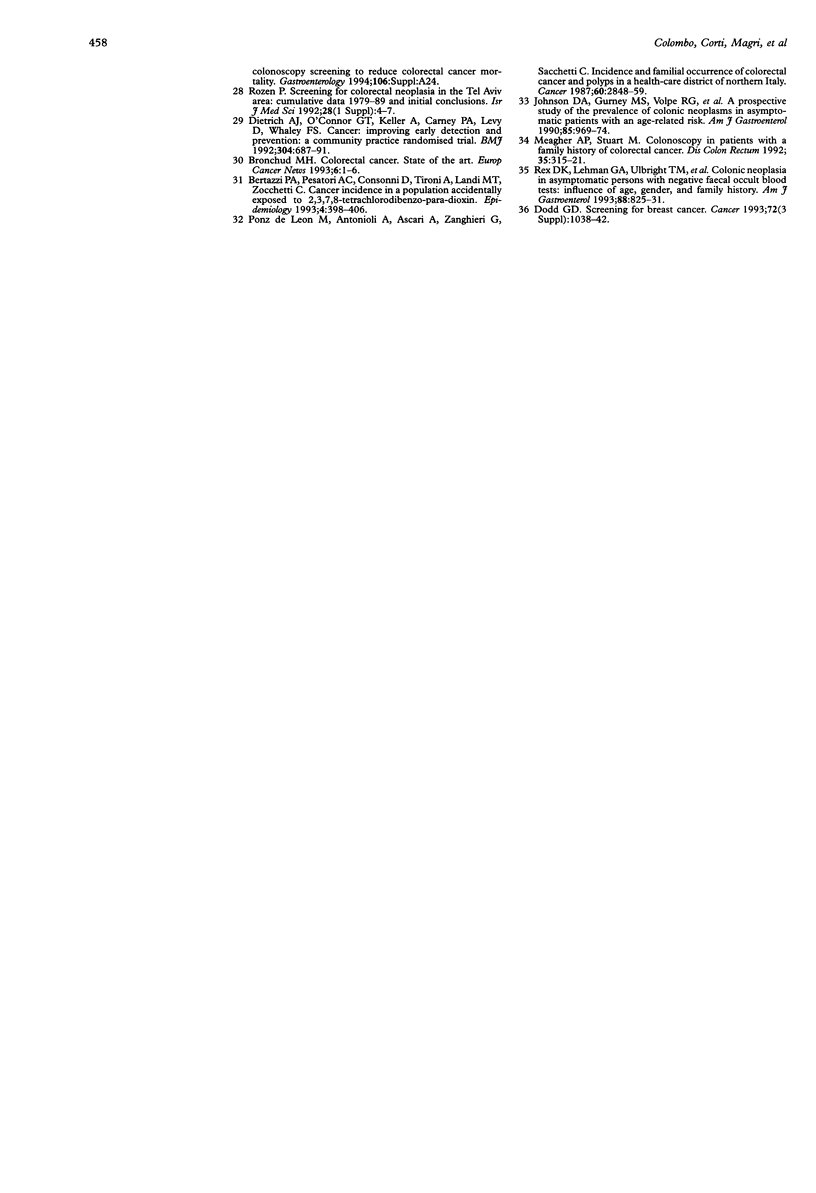
Selected References
These references are in PubMed. This may not be the complete list of references from this article.
- Bertazzi A., Pesatori A. C., Consonni D., Tironi A., Landi M. T., Zocchetti C. Cancer incidence in a population accidentally exposed to 2,3,7,8-tetrachlorodibenzo-para-dioxin. Epidemiology. 1993 Sep;4(5):398–406. doi: 10.1097/00001648-199309000-00004. [DOI] [PubMed] [Google Scholar]
- Dietrich A. J., O'Connor G. T., Keller A., Carney P. A., Levy D., Whaley F. S. Cancer: improving early detection and prevention. A community practice randomised trial. BMJ. 1992 Mar 14;304(6828):687–691. doi: 10.1136/bmj.304.6828.687. [DOI] [PMC free article] [PubMed] [Google Scholar]
- Dodd G. D. Screening for breast cancer. Cancer. 1993 Aug 1;72(3 Suppl):1038–1042. doi: 10.1002/1097-0142(19930801)72:3+<1038::aid-cncr2820721316>3.0.co;2-3. [DOI] [PubMed] [Google Scholar]
- Eddy D. M., Nugent F. W., Eddy J. F., Coller J., Gilbertsen V., Gottlieb L. S., Rice R., Sherlock P., Winawer S. Screening for colorectal cancer in a high-risk population. Results of a mathematical model. Gastroenterology. 1987 Mar;92(3):682–692. doi: 10.1016/0016-5085(87)90018-7. [DOI] [PubMed] [Google Scholar]
- Greenberg E. R., Baron J. A. Prospects for preventing colorectal cancer death. J Natl Cancer Inst. 1993 Aug 4;85(15):1182–1184. doi: 10.1093/jnci/85.15.1182. [DOI] [PubMed] [Google Scholar]
- Johnson D. A., Gurney M. S., Volpe R. J., Jones D. M., VanNess M. M., Chobanian S. J., Avalos J. C., Buck J. L., Kooyman G., Cattau E. L., Jr A prospective study of the prevalence of colonic neoplasms in asymptomatic patients with an age-related risk. Am J Gastroenterol. 1990 Aug;85(8):969–974. [PubMed] [Google Scholar]
- Kimmig J. M., Strauch M., Hallen M. Negative Haemoccult test in malignant and premalignant lesions of the colon. Validation of the Haemoccult test with total colonoscopy. Endoscopy. 1989 May;21(3):136–140. doi: 10.1055/s-2007-1010733. [DOI] [PubMed] [Google Scholar]
- Lang C. A., Ransohoff D. F. Fecal occult blood screening for colorectal cancer. Is mortality reduced by chance selection for screening colonoscopy? JAMA. 1994 Apr 6;271(13):1011–1013. [PubMed] [Google Scholar]
- Mandel J. S., Bond J. H., Church T. R., Snover D. C., Bradley G. M., Schuman L. M., Ederer F. Reducing mortality from colorectal cancer by screening for fecal occult blood. Minnesota Colon Cancer Control Study. N Engl J Med. 1993 May 13;328(19):1365–1371. doi: 10.1056/NEJM199305133281901. [DOI] [PubMed] [Google Scholar]
- Maule W. F. Screening for colorectal cancer by nurse endoscopists. N Engl J Med. 1994 Jan 20;330(3):183–187. doi: 10.1056/NEJM199401203300307. [DOI] [PubMed] [Google Scholar]
- Meagher A. P., Stuart M. Colonoscopy in patients with a family history of colorectal cancer. Dis Colon Rectum. 1992 Apr;35(4):315–321. doi: 10.1007/BF02048107. [DOI] [PubMed] [Google Scholar]
- Neugut A. I. Colon cancer screening in Israel. Isr J Med Sci. 1992 Jan;28(1 Suppl):4–7. [PubMed] [Google Scholar]
- Newcomb P. A., Norfleet R. G., Storer B. E., Surawicz T. S., Marcus P. M. Screening sigmoidoscopy and colorectal cancer mortality. J Natl Cancer Inst. 1992 Oct 21;84(20):1572–1575. doi: 10.1093/jnci/84.20.1572. [DOI] [PubMed] [Google Scholar]
- Ponz de Leon M., Antonioli A., Ascari A., Zanghieri G., Sacchetti C. Incidence and familial occurrence of colorectal cancer and polyps in a health-care district of northern Italy. Cancer. 1987 Dec 1;60(11):2848–2859. doi: 10.1002/1097-0142(19871201)60:11<2848::aid-cncr2820601141>3.0.co;2-f. [DOI] [PubMed] [Google Scholar]
- Ransohoff D. F., Lang C. A. Screening for colorectal cancer. N Engl J Med. 1991 Jul 4;325(1):37–41. doi: 10.1056/NEJM199107043250107. [DOI] [PubMed] [Google Scholar]
- Ransohoff D. F., Lang C. A. Sigmoidoscopic screening in the 1990s. JAMA. 1993 Mar 10;269(10):1278–1281. [PubMed] [Google Scholar]
- Rex D. K., Lehman G. A., Ulbright T. M., Smith J. J., Pound D. C., Hawes R. H., Helper D. J., Wiersema M. J., Langefeld C. D., Li W. Colonic neoplasia in asymptomatic persons with negative fecal occult blood tests: influence of age, gender, and family history. Am J Gastroenterol. 1993 Jun;88(6):825–831. [PubMed] [Google Scholar]
- Sandler R. S., DeVellis B. M., Blalock S. J., Holland K. L. Participation of high-risk subjects in colon cancer screening. Cancer. 1989 Jun 1;63(11):2211–2215. doi: 10.1002/1097-0142(19890601)63:11<2211::aid-cncr2820631125>3.0.co;2-q. [DOI] [PubMed] [Google Scholar]
- Selby J. V., Friedman G. D., Quesenberry C. P., Jr, Weiss N. S. A case-control study of screening sigmoidoscopy and mortality from colorectal cancer. N Engl J Med. 1992 Mar 5;326(10):653–657. doi: 10.1056/NEJM199203053261001. [DOI] [PubMed] [Google Scholar]
- Solomon M. J., McLeod R. S. Screening strategies for colorectal cancer. Surg Clin North Am. 1993 Feb;73(1):31–45. doi: 10.1016/s0039-6109(16)45927-x. [DOI] [PubMed] [Google Scholar]
- Stephenson B. M., Murday V. A., Finan P. J., Quirke P., Dixon M. F., Bishop D. T. Feasibility of family based screening for colorectal neoplasia: experience in one general surgical practice. Gut. 1993 Jan;34(1):96–100. doi: 10.1136/gut.34.1.96. [DOI] [PMC free article] [PubMed] [Google Scholar]
- Toribara N. W., Sleisenger M. H. Screening for colorectal cancer. N Engl J Med. 1995 Mar 30;332(13):861–867. doi: 10.1056/NEJM199503303321306. [DOI] [PubMed] [Google Scholar]
- Vasen H. F., Mecklin J. P., Khan P. M., Lynch H. T. The International Collaborative Group on Hereditary Non-Polyposis Colorectal Cancer (ICG-HNPCC). Dis Colon Rectum. 1991 May;34(5):424–425. doi: 10.1007/BF02053699. [DOI] [PubMed] [Google Scholar]
- Vogelstein B., Fearon E. R., Hamilton S. R., Kern S. E., Preisinger A. C., Leppert M., Nakamura Y., White R., Smits A. M., Bos J. L. Genetic alterations during colorectal-tumor development. N Engl J Med. 1988 Sep 1;319(9):525–532. doi: 10.1056/NEJM198809013190901. [DOI] [PubMed] [Google Scholar]
- Wallich P. Are hospitals heading for intensive care? Sci Am. 1994 Apr;270(4):118–118. doi: 10.1038/scientificamerican0494-118. [DOI] [PubMed] [Google Scholar]
- Warneke J., Petrelli N., Herrera L., Nava H. Accuracy of colonoscopy for the detection of colorectal polyps. Dis Colon Rectum. 1992 Oct;35(10):981–985. doi: 10.1007/BF02253502. [DOI] [PubMed] [Google Scholar]
- Winawer S. J., St John D. J., Bond J. H., Rozen P., Burt R. W., Waye J. D., Kronborg O., O'Brien M. J., Bishop D. T., Kurtz R. C. Prevention of colorectal cancer: guidelines based on new data. WHO Collaborating Center for the Prevention of Colorectal Cancer. Bull World Health Organ. 1995;73(1):7–10. [PMC free article] [PubMed] [Google Scholar]
- Winawer S. J., Zauber A. G., Ho M. N., O'Brien M. J., Gottlieb L. S., Sternberg S. S., Waye J. D., Schapiro M., Bond J. H., Panish J. F. Prevention of colorectal cancer by colonoscopic polypectomy. The National Polyp Study Workgroup. N Engl J Med. 1993 Dec 30;329(27):1977–1981. doi: 10.1056/NEJM199312303292701. [DOI] [PubMed] [Google Scholar]


